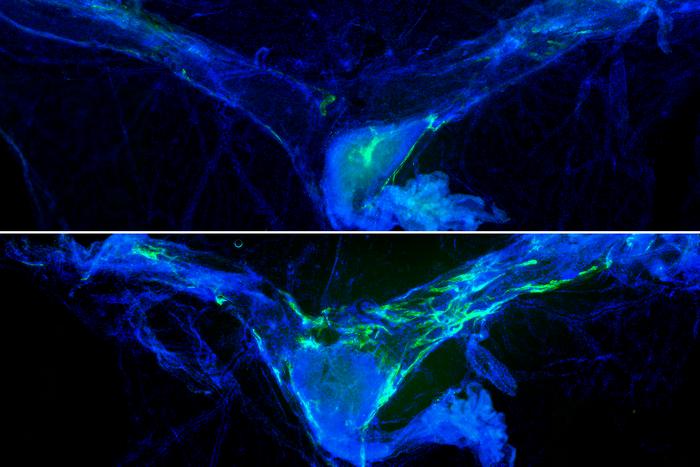The brain’s ability to take out its own trash might be more important than previously thought. New research shows that rejuvenating the brain’s waste removal system can improve memory in older mice, potentially offering a new approach to addressing age-related cognitive decline and neurodegenerative diseases in humans.
Scientists at Washington University School of Medicine in St. Louis have identified a way to boost the effectiveness of vessels that drain waste from the brain. The study, published March 21 in the journal Cell, demonstrates that enhancing this drainage system leads to measurable improvements in memory function in aged mice.
“The physical blood-brain barrier hinders the efficacy of therapies for neurological disorders,” said Jonathan Kipnis, PhD, the Alan A. and Edith L. Wolff Distinguished Professor of Pathology & Immunology and a BJC Investigator at WashU Medicine. “By targeting a network of vessels outside of the brain that is critical for brain health, we see cognitive improvements in mice, opening a window to develop more powerful therapies to prevent or delay cognitive decline.”
The approach takes advantage of a relatively recent discovery. Just a decade ago, Kipnis’s lab identified a network of vessels surrounding the brain—called meningeal lymphatics—in both mice and humans. These vessels drain fluid and waste into lymph nodes, where immune cells monitor for signs of infection or disease.
Starting around age 50, this drainage system begins to falter as part of normal aging, potentially contributing to the buildup of proteins and waste products associated with neurodegenerative conditions like Alzheimer’s and Parkinson’s diseases.
In the morning bustle of Washington University’s research facilities, teams of scientists work meticulously with mice models that could eventually translate to human treatments. Dr. Kyungdeok Kim, a postdoctoral fellow in Kipnis’s lab and the study’s first author, has been focused on understanding how the brain’s waste management system affects cognitive function.
To test memory in mice, Kim’s team placed two identical black rods in cages for twenty minutes, allowing older mice to explore them. The following day, they reintroduced one of the familiar black rods alongside a new object—a silver rectangular prism. Mice with intact memory typically spend more time investigating the novel object, but older mice typically divide their attention more evenly between both objects, suggesting memory impairment.
The researchers then treated some of the older mice with a therapy that stimulates lymphatic vessel growth, enhancing waste drainage from the brain. The results were telling: mice with rejuvenated lymphatic vessels showed greater interest in the new object compared to untreated mice—a sign of improved memory function.
“A functioning lymphatic system is critical for brain health and memory,” said Kim. “Therapies that support the health of the body’s waste management system may have health benefits for a naturally aging brain.”
The findings offer a novel perspective on brain health. Most neurological treatments focus on crossing the blood-brain barrier to directly affect brain tissue. This approach instead targets the drainage system outside the brain, potentially circumventing the need for drugs to penetrate this protective barrier.
When the lymphatic system becomes compromised and waste accumulates in the brain, the cleanup responsibility shifts to microglia—the brain’s resident immune cells. But these local cleaning crews eventually become overwhelmed.
The research revealed that these overtaxed cells release a distress signal in the form of an immune protein called interleukin 6 (IL-6). This protein appears to disrupt normal brain function by creating an imbalance in neuronal signaling.
Specifically, the study found that elevated IL-6 levels reduced inhibitory signals that normally act like noise-canceling headphones among the brain’s communication networks. This disruption altered brain wiring and impaired function.
Interestingly, when researchers boosted lymphatic vessel function in aged mice, IL-6 levels dropped and the brain’s noise-canceling mechanisms were restored—alongside improvements in memory performance.
The approach represents what some neuroscientists consider a paradigm shift in addressing neurological disorders. Rather than trying to repair damaged neurons directly, enhancing waste removal might optimize the functioning of surviving brain cells.
“As we mark the 10th anniversary of our discovery of the brain’s lymphatic system, these new findings provide insight into the importance of this system for brain health,” said Kipnis. “Targeting the more easily accessible lymphatic vessels that are located outside the brain may prove to be an exciting new frontier in the treatment of brain disorders. We may not be able to revive neurons, but we may be able to ensure their most optimal functioning through modulation of meningeal lymphatic vessels.”
The research also builds on previous work from Kipnis’s team showing that certain experimental Alzheimer’s treatments work more effectively in mice when combined with therapies that improve drainage of fluid and debris from the brain.
The current study, supported by funding from the National Institute on Aging and other organizations, adds to growing evidence that the body’s waste management systems play a crucial role in maintaining brain health throughout life.
While the findings remain preliminary and limited to mouse models, they suggest potential new directions for developing therapies to address age-related cognitive decline and possibly neurodegenerative diseases in humans—focusing not just on the brain itself, but on supporting systems that keep it clean and functional.
As researchers continue to explore this emerging field of neuroimmunology, the relationship between the brain’s waste disposal system and cognitive function could reshape approaches to treating a range of neurological conditions that currently have limited treatment options.
If our reporting has informed or inspired you, please consider making a donation. Every contribution, no matter the size, empowers us to continue delivering accurate, engaging, and trustworthy science and medical news. Independent journalism requires time, effort, and resources—your support ensures we can keep uncovering the stories that matter most to you.
Join us in making knowledge accessible and impactful. Thank you for standing with us!

